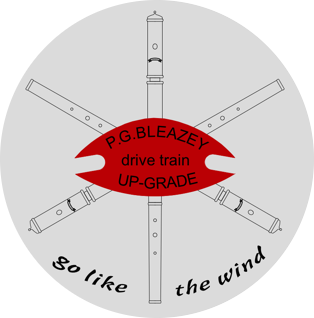Drive Train Upgrade Kit

My upgrade for the Morgan three wheeler drive train comes in three stages:
The bevel box mounting kit
If you still have the original welded in situ mountings then, in my opinion you do not need to upgrade. Any noise reduction achieved will be minimal.
The bevel box mountings must be fitted before stage 2 which can be fitted at a later date.
Stage 2
The Centa coupling upgrade kit
The upgrade kit contains an extension for the shaft which supports the inner rotor of the Centa coupling, this extension runs in a plain bearing. The bearing is mounted in a carrier which fits within the Centa coupling outer rotor. The intermediate shaft is thus supported at both ends which creates a much more rigid, true running, unit. Please do not fit my design of inserts without the support bearing. In any case I recommend fitting a support bearing at the earliest opportunity.
Please be aware that the inserts in a Centa coupling are consumable - like tyres and brake pads- they have to be replaced at regular intervals. My non rolling inserts are designed with longevity in mind and I hope they will outlast any other alternative but in common with all the available alternatives, they are not immortal.
When the inserts come to the end of their life it is necessary to remove the engine in order to replace them - at least 12 hours work for a mechanic - UNLESS you go for stage three!
PRICE :- for stage 1 and 2 ordered together £ 726:40 including postage at your own risk. If you would like the parcel insured please add £ 25:00
PRICE :- for stage 1 (aluminium billet mounts) and 2 ordered together £ 1,050:40 including postage at your own risk. If you would like the parcel insured please add £ 25:00
Stage three:
Quick change coupling insert modifications
The modifications consist of an enlargement of the grease gun access hole in the bottom of the bell housing and the re-machining of the inner rotor so that the insert retaining plate can be removed from the rear end to give access to remove the inserts.
For those who choose to have this mod done locally or if you want to do it yourself, I have made drawing and instructions available please click on the link at the top of the page. Having done the mods fix the plate to the rotor with four M8 socket head screws 16mm long NO LOCTITE. four more socket head screws 16mm long should be inserted and loctited in to the four holes in the aluminium outer rotor - these are used to turn the engine over while removing the securing plate and the inserts
To remove the bell housing you must heat the area of aluminium around the four fixing bolts to soften the loctite. The screws are imperial and you will need a long series 1/4 inch allen wrench driven by your socket set tommy bar. It is essential to re fit them with loctite and torque them down to 30ft lbs. or 40 newton metres. these are the bolts that hold the primary chaincase on to the crankcase in motorcycle installations. they are very small for the Morgan set up and need to be tightened correctly.
After the mod is carried out, with the vehicle safely raised to give access from below, you can get one hand in through the bell housing cut out. With the spark plugs removed, use a 1/4" drive ratchet hex key to loosen and remove the 4 M8 bolts. once inserted a sharp blow to the end of the ratchet with the side of your fist will loosen them, if the ratchet is short you will need an extension handle. Do not allow these screws to become contaminated with dirt or grit it is essential that they never sieze up in the thread or removing them will become difficult in the extreme! The four M8 socket head bolts in the outer aluminium rotor can be used, in a clockwise direction, to turn the engine over. Slide the retaining plate all the way back to the end plate. Use one of the bolts or a wood screw and push it in the the 7mm. hole in the insert and it can the be used to pull the insert out far enough to get hold of it with you fingers and extract it through the hole in the bell housing - you may need to get an assistant to wiggle the shaft back and forth while pulling, in order to get the first one loose. DO NOT WORK ON THIS UNLESS YOU HAVE THE IGNITION KEY IN YOUR POCKET - SAFETY FIRST!. To access the insert at the top you will have to turn the engine over - you should have the SPARK PLUGS REMOVED to make this easier. If all three wheels are off the ground, with top gear engaged, you can turn the rear wheel to turn the engine over. Alternatively remove the transmission tunnel cover and turn the propshaft with a long screwdriver inserted in the UJ.
LIMITATIONS
Lugging the motor , an expression used by S&S and something to be avoided. The reason for this is not too clear without some research but I can give the following advice. Loading the engine up at low Revs. causes the pistons to be pushed to one side of the bore, this may be due to short piston skirt length. The result is over consumption of oil and all the problems which accompany this. In a recent 1500 mile road test I utilised the ability to accelerate hard at low revs. - very satisfying it is too - nothing quite as satisfying as hearing the rear tyre break away at every firing stroke! However - the cost was 2.5 litres of oil lost in 1,000 miles which will bring disaster if one continues driving in this fashion. The P.G.Bleazey drive train upgrade kit will allow you to do this but it is imperative that if you use low rpm, for example, in dense traffic, you only employ small throttle openings till the revs. rise above 2,500 rpm. Alternatively just change down a gear to get the revs up but DON'T just push the pedal to the floor at low engine speeds!
The internal splines of the Centa coupling outer rotor are made of soft steel. They run on a hardened, alloy steel, splined crankshaft. The fit is only on the driving faces of the splines making this a very vulnerable area. Lugging the motor may also result in the soft internal splines being hammered and distorted to the point that they will become loose on the crankshaft. To repair this is expensive. My machine has an alloy steel insert in the outer rotor, fitted on the drive faces and on both major and minor diameters, to avoid any recurrence of this failure.
On all of the machines I have examined I have noticed another likely cause of trouble. The bearing behind the clutch is not secured to the shaft other than by the interference fit. There is a circlip groove but it is about 3 mm away from the bearing inner race and has no clip fitted which could allow the shaft to move. The only retaining force would then be contact with the gearbox shaft within the spigot bearing.
I will not accept responsibility for such failures - they are caused by inadequate design and are not under my control.
INSTALLATION
The kit can be installed by any competent motor mechanic, professional or experienced amateur. A full installation manual is available in on another page, just click the links at the top of this page. I am happy for the installation manual to be printed off and for it to be passed to your garage mechanic if you are not doing the work yourself. Please feel free to study it before deciding to purchase a kit. I am also available, within the limits of my daily life, to give advice via e-mail or telephone to anyone with installation problems. To the best of my ability I promise to provide technical backup to customers.
With the exception of the stage three modifications ,the kit does not require any alteration of the vehicle components and can be removed and replaced by the original equipment, not that I can foresee anyone wanting to do this but it may bring peace of mind to the sceptical.
The P.G.Bleazey drive train upgrade kit can be described for insurance purposes as not being performance enhancing but merely comfort enhancing.




